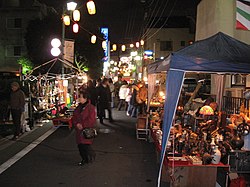Musashi-Seki Station
SS14 Musashi-Seki Station 武蔵関駅 | |||||||||||
|---|---|---|---|---|---|---|---|---|---|---|---|
 South entrance, April 2021 | |||||||||||
| General information | |||||||||||
| Location | 2-29-1 Sekimachikita, Nerima, Tokyo (東京都練馬区関町北) Japan | ||||||||||
| Operated by | Seibu Railway | ||||||||||
| Line(s) | Seibu Shinjuku Line | ||||||||||
| Platforms | 2 side platforms | ||||||||||
| Tracks | 2 | ||||||||||
| Connections |
| ||||||||||
| Other information | |||||||||||
| Station code | SS14 | ||||||||||
| History | |||||||||||
| Opened | 16 April 1927 | ||||||||||
| Passengers | |||||||||||
| FY2013 | 28,803 daily | ||||||||||
| Services | |||||||||||
| |||||||||||
Musashi-Seki Station (武蔵関駅, Musashi-Seki-eki) is a railway station on the Seibu Shinjuku Line in Nerima Ward, Tokyo, Japan, operated by the private railway operator Seibu Railway.[1] Its station number is SS14.
Lines
[edit]Musashi-Seki Station is served by the 47.5 km Seibu Shinjuku Line from Seibu-Shinjuku in Tokyo to Hon-Kawagoe in Saitama Prefecture. Located between Kami-Shakujii and Higashi-Fushimi, it lies 14.4 km from the Shinjuku terminus.[2] Only all-stations "Local" services and "Semi-Express" services stop at this station.[3]
Station layout
[edit]The station structure is located over the tracks, with one set of ticket barriers, and station entrances on the north and south sides.
-
North entrance, March 2025
-
The ticket barriers, June 2022
Platforms
[edit]The station is composed of two side platforms serving two tracks.[1]
| 1 | for Tanashi, Tokorozawa, Haijima, and Hon-Kawagoe | |
| 2 | for Takadanobaba and Seibu-Shinjuku |
-
View from the east (Shinjuku) end of platform 1, December 2012
-
View from the west (Kawagoe) end of platform 1, December 2012
History
[edit]The station opened on 16 April 1927.[2]
Station numbering was introduced on all Seibu Railway lines during fiscal 2012, with Musashi-Seki Station becoming "SS14".[4]
Passenger statistics
[edit]In fiscal 2013, the station was the 34th busiest on the Seibu network with an average of 28,803 passengers daily.[5]
The passenger figures for previous years are as shown below.
| Fiscal year | Daily average |
|---|---|
| 2009 | 28,859[6] |
| 2010 | 28,091[6] |
| 2011 | 27,864[7] |
| 2012 | 28,477[5] |
| 2013 | 28,803[5] |
Surrounding Area
[edit]North Side
[edit]
North of the station is Honryūji Temple, known for the traditional Seki-no-Boroichi flea market, which has been held every December since 1751 during the Edo period.
Parks and Shrines
[edit]- Honryūji Temple
- Jesuit Kami-Shakujii Monastery
Educational Institutions
[edit]- Sophia University Shakujii campus
- Japan Catholic Seminary
- Tokyo Shakujii High School
- Tokyo Joshi Gakuin Junior & Senior High School
- Sekimachi-Kita Elementary School
Rivers and Roads
[edit]South Side
[edit]South of the station is Musashi-Seki Park, a ward-operated park known for its cherry blossoms in spring and rentable boats. The local Ward Office and several Japanese animation studios are also located near the south exit.
Parks and Shrines
[edit]- Musashi-Seki Park
- Tenso Wakamiya Hachimangū Shrine (established in the Nara period)[8]
- St. Therese of the Infant Jesus Church (Sekimachi Catholic Church)
- Asahi Production
- ascension Inc.
- Diomedéa
- Kachigarasu (Encourage Films)
- Studio Blanc
- Studio Gallop
- Studio Tulip
Public Institutions
[edit]- Nerima Ward Seki Residents’ Office (Seki Community Center and Civic Hall)
- Shakujii Police Station (Musashi-Seki Ekimae police box)
- Shakujii Fire Station (Sekimachi branch)
Financial Institutions
[edit]- Nerima Sekimachi Post Office
- Sumitomo Mitsui Banking Corporation Musashi-Seki Branch
- JA Tokyo Aoba Sekimachi Branch
- Tokyo Shinkin Bank Musashi-Seki Branch
Companies and Stores
[edit]- Akidai Main Branch (Sekimachi)
Educational Institutions
[edit]- Sekimachi Elementary School
- Shakujii-Nishi Elementary School
- Shakujii-Nishi Junior High School
Rivers and Roads
[edit]References
[edit]- ^ a b 各駅のご案内: 武蔵関駅 [Station information: Musashi-Seki Station] (in Japanese). Japan: Seibu Railway. Archived from the original on 2 November 2012. Retrieved 1 December 2012.
- ^ a b Terada, Hirokazu (July 2002). データブック日本の私鉄 [Databook: Japan's Private Railways]. Japan: Neko Publishing. p. 202. ISBN 4-87366-874-3.
- ^ 路線図・停車駅 [Route and station stop information] (in Japanese). Japan: Seibu Railway. Archived from the original on 25 November 2012. Retrieved 1 December 2012.
- ^ 西武線全駅で駅ナンバリングを導入します [Station numbering to be introduced at all Seibu stations] (PDF). News Release (in Japanese). Japan: Seibu Railway. 23 February 2012. Archived from the original (PDF) on 24 September 2015. Retrieved 8 March 2013.
- ^ a b c 駅別乗降人員 2013(平成25)年度 1日平均 [Average daily station usage figures (fiscal 2013)] (PDF) (in Japanese). Japan: Seibu Railway. Archived from the original (PDF) on 14 July 2014. Retrieved 17 July 2014.
- ^ a b 駅別乗降人員 2010(平成22)年度 1日平均 [Passenger usage statistics by station (Fiscal 2010)] (PDF) (in Japanese). Japan: Seibu Railway. June 2011. Archived from the original (PDF) on 26 June 2011. Retrieved 6 January 2013.
- ^ 駅別乗降人員 2011(平成23)年度 1日平均 [Passenger usage statistics by station (Fiscal 2011)] (PDF) (in Japanese). Japan: Seibu Railway. May 2012. Archived from the original (PDF) on 1 November 2012. Retrieved 6 January 2013.
- ^ "天祖若宮八幡宮". 東京都神社庁. Retrieved 21 October 2019.
External links
[edit]- Musashi-Seki Station information (Seibu) (in Japanese)




